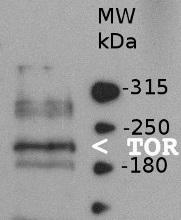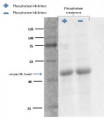1

Anti-TOR | Target of rapamycin
AS12 2608 | Clonality: Polyclonal | Host: Rabbit | Reactivity: Arabidopsis thaliana, Zea mays
- Product Info
-
Immunogen: KLH-conjugated synthetic peptide derived from Arabidopsis thaliana TOR protein sequence, UniProt: Q9FR53, TAIR: AT1G50030
Host: Rabbit Clonality: Polyclonal Purity: Immunogen affinity purified serum in PBS pH 7.4. Format: Lyophilized Quantity: 50 µg Reconstitution: For reconstitution add 50 µl of sterile water Storage: Store lyophilized/reconstituted at -20°C; once reconstituted make aliquots to avoid repeated freeze-thaw cycles. Please remember to spin the tubes briefly prior to opening them to avoid any losses that might occur from material adhering to the cap or sides of the tube. Tested applications: Western blot (WB) Recommended dilution: 1 : 5000 (WB) Expected | apparent MW: 279 kDa
- Reactivity
-
Confirmed reactivity: Arabidopsis thaliana, Zea mays
Predicted reactivity: Cucumis sativus, Glycne max, Nicotiana tabacum, Oryza sativa, Phaseolus vulgaris, Physcomitrium patens, Populus trichocarpa, Setaria italica, Setaria viridis, Solanum tuberosum, Sorghum bicolor, Vitis vinifera
Species of your interest not listed? Contact usNot reactive in: Chlamydomonas reinhardtii
- Application Examples
-
application information 
10 of Arabidopsis thaliana 10dag (day-after-germination) seedlings grown on MS agar plate were homogenised in 1.5 Eppis (safe-lock) in Precellys machine (glass beads + N2 liquid) 2x 7'' at max speed. 100uL of 1.5x (Laemmli buffer + 10% BME) was added and samples were boiled at 95C for 5 minutes followed by a 15 minutes centrifugation at max rpm, was loaded in the amount of 40uL per lane and separated on 8% SDS-PAGE. Blotting was done for 1 h at 100 V to PVDF using tank transfer. Blots were blocked with 2 % BSA in 1xPBS-Tween20 0.1% for 1h at RT with agitation. Blot was incubated in the primary antibody at a dilution of 1: 5 000 in 1x PBS-Tween 20 0.1% over night at 4C with agitation. The antibody solution was decanted and the blot was briefly rinsed, then washed 3 times for 10 min in 1xPBS-Tween20 0.1% at RT with agitation. Blot was incubated in secondary antibody (anti-rabbit IgG horse radish peroxidase conjugated) diluted to 1:20 000 in 1xPBS-Tween20 0.1% for 2h at RT with agitation. The blot was washed as above and developed for 1 minute chemiluminescent detection reagent. Exposure time was 30 seconds.
Courtesy of Dr. Mikhail Schepetilnikov, Institut de Biologie Moléculaire des Plantes, CNRS, France
25 mg total protein extract (35S:Raptor-ProtG) was incubated with IgG magnetic beads for 50 minutes. After washing, complexes were eluted, concentrated by speedvac and pellet was dissolved in 30uL 1x sample buffer. For SDS-PAGE 10uL of the eluate was loaded on gel. 20, 40, and 60 μg total protein extract from Arabidopsis thaliana cell suspension culture (Landsberg erecta), or AtTOR protein enriched by immunoprecipitation using AtRAPTOR1B was separated on 4-15 % gradient TGX (Biorad) SDS-PAGE and blotted 15 min. to PVDF using the Trans-Blot Turbo system (setting high MW). As negative control, an unrelated immunoprecipitated sample was loaded. Blots were blocked overnight with 1% PVP40 in TBS-T at 4°C with agitation. Blot was incubated with the primary anti-TOR antibody at a dilution of 1: 1 000 in blocking buffer for 4h at room temperature (RT) with agitation. The antibody solution was decanted and the blot was rinsed briefly once, then washed once for 15 min and 3 times for 5 min in TBS-T at RT with agitation. Blot was incubated in secondary antibody (anti-rabbit IgG horse radish peroxidase conjugated, from Agrisera AS09 602) diluted to 1: 20 000 in blocking buffer for 1h at RT with agitation. The blot was washed as above and developed for 1 min with ECL according to the manufacturer's instructions. Exposure time was 10 seconds.
TOR protein (red arrow) detected after enrichment by immunoprecipitation with IgG beads and Raptor-ProtG fusion, while TOR band is absent in control IP with unrelated ProtG-tagged bait. - Additional Information
-
Additional information (application): TOR is a subjected to post-translational modifications (ubiquitination and phosphorylation), which can change the migration pattern in SDS gel - Background
-
Background: TOR (Target of rapamycin) is an essential cell growth regulator that controls development from early embryo to seed production in response to nutrient availability in envoronmental stress conditions. It belongs to the family of phosphatidylinositol 3-kinase and are targets of the antiproliferative drug rapamycin. AtTOR is expressed in embryos, endosperm and meristems. Acts through the phosphorylation of downstream effectors that are recruited by the binding partner RAPTOR. Acts by activating transcription, protein synthesis and ribosome biogenesis, and inhibiting mRNA degradation and autophagy. - Product Citations
-
Selected references: Garcia et al. (2017). Maize defective kernel mutant generated by insertion of a Ds element in a gene encoding a highly conserved TTI2 cochaperone. Proc Natl Acad Sci U S A. 2017 May 16;114(20):5165-5170. doi: 10.1073/pnas.1703498114. - Protocols
-
- Reviews:
-
This product doesn't have any reviews.



